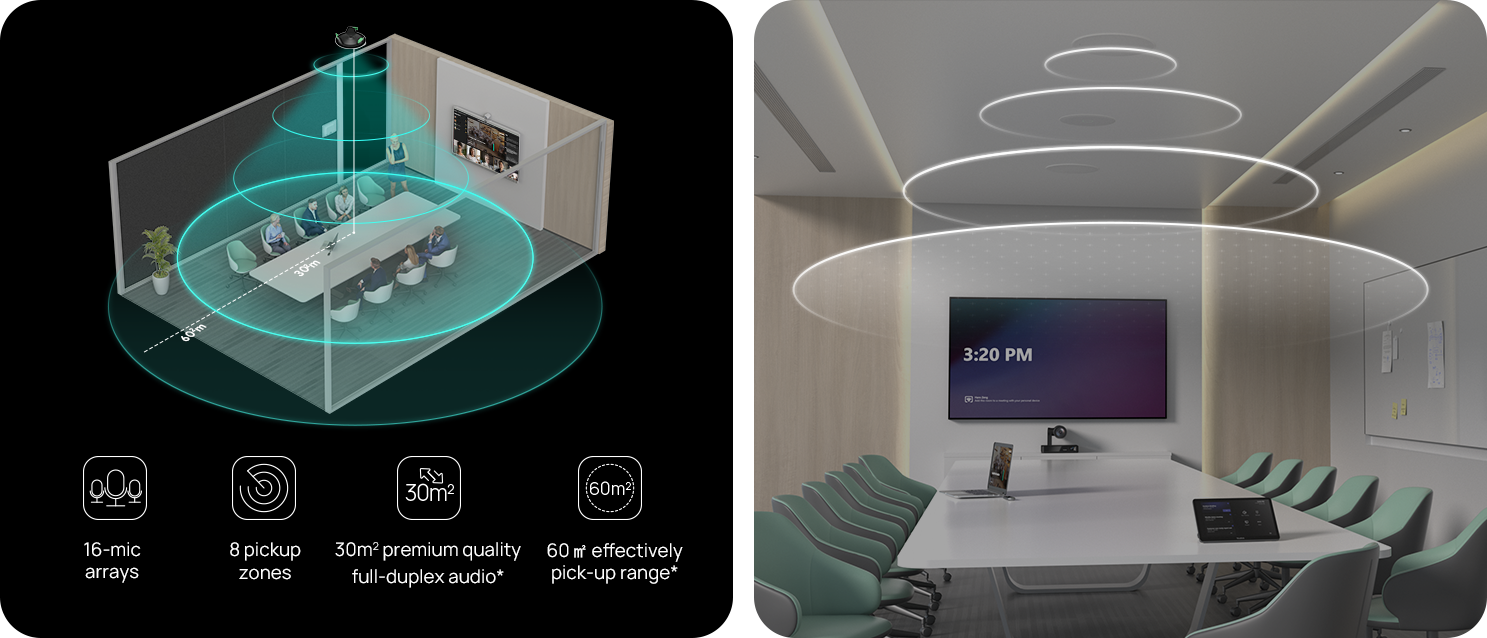Conference Room Space
Designing the Ideal Environment for Meetings



Creating an effective conference room space is crucial for facilitating productive meetings and fostering collaboration, whether for in-person discussions, video conferences, or hybrid meetings. With the rise of remote and hybrid work models, the design of conference room spaces has evolved to accommodate both physical and virtual participants, ensuring seamless communication and engagement.
In this article, we will explore the key elements to consider when designing a conference room space, the necessary technologies, and how to optimize these spaces for different meeting scenarios, including small, medium, and large conference rooms.

The size and layout of the conference room are essential factors in determining its functionality and how it will be used. Depending on the number of participants, the room should be spacious enough to ensure comfort and ease of movement.
Small Conference Rooms: Typically designed for up to 4-6 people, small conference rooms should offer a comfortable and intimate setting for focused discussions. A round or rectangular table can promote better interaction. With compact solutions such as the Yealink MeetingBar A10, these rooms can easily be equipped with high-quality audio and video technology for video calls and hybrid meetings.
Medium Conference Rooms: Ideal for 6-12 people, medium-sized conference rooms require more space for larger tables and additional equipment. A hybrid meeting room solution, such as the Yealink MeetingBar A30, is perfect for medium rooms, providing all-in-one video conferencing capabilities and enhancing collaboration with both in-room and remote participants.
Large Conference Rooms: Designed for 12+ participants, large rooms need more advanced equipment, including high-end video conferencing systems like the Yealink MVC940 for large rooms. These systems offer multi-camera setups, ensuring that all participants can be seen and heard clearly. Additionally, these rooms may require additional space for more chairs and a larger conference table.
For today’s conference rooms, integrating reliable and high-quality video conferencing technology is essential. Whether for remote collaboration or virtual meetings, technology is the backbone of modern conference rooms. Here’s what to consider:
All-in-One Video Bars: Devices like the Yealink MeetingBar A20 and Yealink MeetingBar A40 combine cameras, microphones, and speakers into a single device, minimizing cable clutter while delivering professional-quality video and audio. These devices are perfect for small to medium-sized rooms and are compatible with popular video conferencing platforms such as Microsoft Teams and Zoom.
Multi-Camera Systems for Larger Rooms: For large rooms or conference spaces, a multi-camera solution like the Yealink MVC940 provides panoramic views, ensuring that every participant can be seen. These systems include high-definition cameras that can track active speakers, providing a more immersive experience for remote attendees.
Wireless Presentation Systems: To promote seamless collaboration, wireless presentation systems such as Yealink’s wireless casting allow users to share their screens without the need for cables or adapters. This enhances the flow of presentations, making it easy to collaborate on documents or visual content during meetings.

Good audio quality is crucial for any conference room. Participants, whether in the room or joining remotely, must be able to hear and speak clearly without distractions or interference.
Microphone Arrays: Devices such as the Yealink VCM34 microphone array or Yealink VCM38 are excellent choices for conference rooms. These microphone arrays ensure that every participant in the room can be heard clearly by remote attendees, even if they’re seated at the far end of the table.
Noise-Canceling Technology: Incorporating noise-canceling technologies in microphones or speakers, like those in Yealink’s audio solutions, can eliminate background noise, ensuring a crisp and clear meeting experience. This is particularly important in open office spaces or home offices with unpredictable noise levels.
Speakers with Full-Duplex Audio: Full-duplex speakers allow for two-way communication without cutting off or distorting the conversation, making interactions smoother. The Yealink CP960 speakerphone is a great option for conference rooms, offering high-quality audio and easy integration with various video conferencing platforms.
The right lighting and acoustic design can greatly enhance the functionality of a conference room. Poor lighting or sound quality can detract from the effectiveness of meetings, especially for virtual participants.
Lighting: Conference rooms should have adjustable lighting to ensure participants are well-lit without harsh glare. Consider a combination of ambient lighting and task lighting above the table for optimal visibility. Smart lighting solutions, such as adjustable LED lights, can be used to enhance video call quality and participant comfort.
Acoustic Treatment: To avoid echoes or sound distortion, acoustic treatment is key in a conference room. Installing sound-absorbing materials such as acoustic panels or foam tiles can improve speech clarity and reduce background noise. The room should also be arranged to minimize hard surfaces that can bounce sound, like glass windows or empty walls.
The comfort and ergonomics of the furniture in a conference room can impact the productivity and overall experience of the meeting. Here are key considerations:
Ergonomic Seating: Chairs should be comfortable and adjustable, supporting long meetings without causing discomfort. Ensure that the seats are arranged in a way that allows everyone to see and interact with one another easily.
Adjustable Tables: For flexibility, use tables that can be easily reconfigured for different meeting types, from small brainstorming sessions to large presentations. Modular tables that can be moved and adjusted help maximize the room’s flexibility.
Cable Management: Tidy cable management is important to avoid clutter. Cable trays, under-table cable management, and wireless charging stations can ensure a neat and professional conference room setup.
With the rise of hybrid working models, it’s essential for conference rooms to support both in-person and remote attendees simultaneously. Here’s how to optimize a room for hybrid meetings:
Camera and Audio for Hybrid Meetings: Use high-definition cameras with speaker-tracking technology to ensure that remote participants can follow the meeting and see the right speaker. The Yealink MeetingBoard 65 is a perfect solution for hybrid meetings, combining an interactive whiteboard with an HD camera for a seamless experience.
Screen Sharing and Interactive Whiteboards: Devices like Yealink’s MeetingBoard 65 or Yealink DeskVision A24 allow both in-room and remote participants to interact with presentations, make annotations, and share content in real-time.
Collaboration Tools: Incorporating Microsoft Teams or Zoom integration into the conference room’s hardware ensures smooth collaboration and easy connection to virtual meetings. Meeting room systems like Yealink MVC Series are equipped to seamlessly connect to these platforms and support collaboration across multiple devices.
Efficiently managing the use of conference rooms is important, especially in large organizations with many employees working in different locations. Here’s how to streamline the process:
Room Scheduling Software: Integrate room booking systems such as Microsoft Outlook or Google Calendar to allow employees to easily book conference rooms, view availability, and avoid scheduling conflicts.
Room Panels: Yealink RoomPanel can be installed outside conference rooms to show real-time availability and allow quick booking or adjustments. These panels can sync with your room scheduling software and ensure smooth room management.
Centralized Control Systems: Having a single touchpoint to control the audio, video, and lighting systems can simplify room use. Yealink’s MTouch is an example of a centralized control system that allows easy control of all conference room equipment from a single device.
Designing an effective conference room space is essential for fostering productive and efficient meetings, whether in-person, virtual, or hybrid. By considering the size and layout, video conferencing technology, audio quality, lighting, and furniture, you can create a space that supports collaboration and enhances communication.
Tips:This article is for reference only. Please visit the Yealink product details page to learn more about products and application scenarios.
All-In-One Video Conferencing Device
Easy to install and quickly deploy, it ensures seamless connectivity and integration, delivering exceptional value for efficient remote meetings.
Video Conferencing Bundled device Covering from Huddle to Medium Conference Room
Video Conferencing Bundled device Covering from Medium to Extra-Large Conference Room
How Can We Help You?
Not sure how it fits into your environment? Our AV specialists are here to help.
👉 Get deployment advice for your conference room and system.
👉 Need a quote? Request a custom pricing.
Please fill in and submit the information below and our representative will contact you soon.







